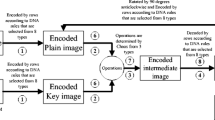Abstract
In this study, a multiple digital image encryption algorithm based on chaos algorithm is presented. The cyclic matrix is constructed by logical mapping, and sparse transformation of plaintext image is realized by discrete cosine transform (DCT). The gray image of DCT is measured, and several digital images are merged. Lorenz chaotic system and logistic map are adopted to generate chaotic key sequence related to plaintext image features, replace pixel value, scramble pixel position, diffuse image, and finally obtain ciphertext image. It encrypts many kinds of digital images. The proposed encryption algorithm has excellent image encryption effect and high security.






Similar content being viewed by others
References
Luo Y, Zhou R, Liu J et al (2018) A parallel image encryption algorithm based on the piecewise linear chaotic map and hyper-chaotic map. Nonlinear Dyn 93:1165–1181
Dzwonkowski M, Roman et al (2019) Secure quaternion Feistel cipher for DICOM images. IEEE Transactions on Image Processing 28(1):371–380
Gao Z, Chen D, Zhang W et al (2018) Colour image encryption algorithm using one-time key and FrFT. IET Image Proc 12(4):472–478
Lia C, Lina D, Jinhu Lu et al (2019) Cryptanalyzing an image encryption algorithm based on autoblocking and electrocardiography. IEEE Multimedia 25(4):46–56
Arslan S, Junaid S (2018) Novel image encryption cryptosystem based on binary bit planes extraction and multiple chaotic maps. European Physical Journal Plus 133(8):331–347
Xue Z, Meng X, Wang Y et al (2018) Hierarchical multiple-image encryption based on the cascaded interference structure and vector stochastic decomposition algorithm. Opt Lasers Eng 107:258–264
Lijun Z, Huihui B, Anhong W et al (2018) Multiple description convolutional neural networks for image compression. IEEE Trans Circuits Syst Video Technol 28:1–13
Zarebnia M, Pakmanesh H, Parvaz RA (2019) Fast multiple-image encryption algorithm based on hybrid chaotic systems for gray scale images. Optik 179:761–773
Raza SF, Satpute V (2018) A novel bit permutation-based image encryption algorithm. Nonlinear Dyn 95:859–873
Li R, Liu Q, Liu L (2018) Novel image encryption algorithm based on improved logistic map. IET Image Proc 13(1):125–134
Liu H, Kadir A, Liu J (2019) Color pathological image encryption algorithm using arithmetic over Galois field and coupled hyper chaotic system. Opt Lasers Eng 122:123–133
Wang Q (2019) Research on medical image encryption algorithm based on bit-plane decomposition and hyper chaos. Computer Simulation 36(1):209–212+353
He Y et al (2019) Image quality enhanced recognition of laser cavity based on improved random hough transform. J Vis Commun Image Represent 102679
Lv Z, Qiao L (2020) Analysis of healthcare big data. Futur Gener Comput Syst 109:103–110
Fu X, Pace P, Aloi G, et al (2020) Topology optimization against cascading failures on wireless sensor networks using a memetic algorithm. Computer Networks (Amsterdam, Netherlands: 1999) 177:107327
Xiong Q, Zhang X, Wang W et al (2020) A parallel algorithm framework for feature extraction of EEG signals on MPI. Comput Math Methods Med 1–10
Zhao C, Ren H (2020) Image encryption based on hyper-chaotic multi-attractors. Nonlinear Dyn 100:679–698
Gafsi M, Abbassi N, Hajjaji MA et al (2020) Improved chaos-based cryptosystem for medical image encryption and decryption. Sci Program 2020(11):1–22
Ni T et al (2020) A cost-effective TSV repair architecture for clustered faults in 3D IC. IEEE Transactions on Computer-Aided Design of Integrated Circuits and Systems 1–5
Chong F, Lin BB, Miao YS et al (2011) A novel chaos-based bit-level permutation scheme for digital image encryption. Optics Commun 284(23):5415–5423
Aashiq BS, Amirtharajan RA (2020) Robust medical image encryption in dual domain: Chaos-DNA-IWT combined approach. Med Biol Eng Compu 58:1445–1458
Cheng N, Wang X (2019) Color image encryption algorithm based on chaotic gyrator transform and Matrix decomposition. Journal of Electronic Measurement and Instrumentation 33(01):191–202
Jiang Q et al (2019) Unified no-reference quality assessment of singly and multiply distorted stereoscopic images. IEEE Trans Image Process 28(4):1866–1881
Ge B, Luo HB (2020) Image encryption application of chaotic sequences incorporating quantum keys. Int Autom Comput 17(01):123–138
Gong K, Guan JH, Kim KG et al (2019) Iterative PET image reconstruction using convolutional neural network representation. IEEE transactions on medical imaging 38(3)
Satria Y, Suryadi MT, Cahyadi DJ (2021) Digital text and digital image encryption and steganography method based on SIYu map and least significant bit. J Phys Conf Ser 1821(1):012035(11pp)
Medvedeva M, Simos TE, Tsitouras C et al (2021) Direct estimation of SIR model parameters through second-order finite differences. Mathematical Methods in The Applied Sciences 44(5):3819–3826
Hu G, Li B (2021) Coupling chaotic system based on unit transform and its applications in image encryption. Signal Processing 178:107790
Funding
The Research was supported by the Science and Technology Project of China Southern Power Grid Co., Ltd. under Grant No. GZKJXM20160018; The National Natural Science Foundation of China under Grant No. 51867005; The Outstanding Young Scientific Talent Training Program of Guizhou province under Grant No. 20195667.
Author information
Authors and Affiliations
Corresponding author
Additional information
Publisher's Note
Springer Nature remains neutral with regard to jurisdictional claims in published maps and institutional affiliations.
Rights and permissions
About this article
Cite this article
Zhang, Y., He, Y., Zhang, J. et al. Multiple Digital Image Encryption Algorithm Based on Chaos Algorithm. Mobile Netw Appl 27, 1349–1358 (2022). https://doi.org/10.1007/s11036-022-01923-9
Accepted:
Published:
Issue Date:
DOI: https://doi.org/10.1007/s11036-022-01923-9




